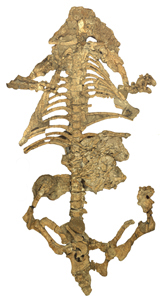 Recent excavations
in China’s Liaoning province have uncovered a well-preserved complete skeleton
of a dog-sized mammal, alongside a cat-sized mammal that had the remains of
its last supper — a young dinosaur — fossilized in its stomach. The
findings not only are the first evidence of a mammal eating a dinosaur, but
also open the door for more speculation on the size and development of mammals.
Recent excavations
in China’s Liaoning province have uncovered a well-preserved complete skeleton
of a dog-sized mammal, alongside a cat-sized mammal that had the remains of
its last supper — a young dinosaur — fossilized in its stomach. The
findings not only are the first evidence of a mammal eating a dinosaur, but
also open the door for more speculation on the size and development of mammals.These two fossils, of Repenomamus giganticus — a new species and the larger of the two — and Repenomamus robustus, were excavated out of the fossil-rich Yixian Formation by local residents in 2002 and 2003, says Yaoming Hu, a paleontologist with the American Museum of Natural History in New York City, and lead author of a paper describing the finds in the Jan. 13 Nature. Fossils of dinosaurs, mammals, frogs, prehistoric birds, plants, insects and more have come out of the Yixian Formation. Radiometric dating puts the site at 128 to 139 million years old, during the peak of the “Age of Dinosaurs,” when mammals were thought to be rodent-sized insect-eating critters that cowered in the shadows of dinosaurs and only came out at night to forage.
Excavations in China led to the discovery of two important 130-million-year-old fossilized mammals: Repenomamus giganticus, the largest mammal found to date from the Cretaceous, and Repenomamus robustus (left), a cat-sized mammal found with a small dinosaur preserved in its stomach area (the tangled mass in the middle of the fossil), thus providing the first direct evidence that mammals preyed on dinosaurs. Photos courtesy of Yaoming Hu, AMNH.
Traditionally, paleontologists have thought that mammals were “forced to remain small by a combination of heavy predation pressure from dinosaurs and the saturation of ecological niches by large reptiles,” wrote Anne Weil, a paleontologist at Duke University in North Carolina, in an accompanying commentary in Nature. Now it appears that mammals may have produced predation pressure on dinosaurs as well, she says: Perhaps mammals might have affected how quickly dinosaurs grew and evolved instead of the other way around.
For animals, “body size is one of the most important factors in influencing life history strategy,” Hu and colleagues wrote. These large Mesozoic mammals likely competed with dinosaurs for food and territory, he says.
“In the Mesozoic, the rule was that no matter what size you were, there was always someone ready to eat you,” says Kevin Padian, a paleontologist at the University of California, Berkeley. And because mammals are carnivorous by default, it shouldn’t be a surprise, he says, to find that larger mammals would have preyed on anything smaller than themselves, including dinosaurs.
R. giganticus, the new species of Repenomamus, was a 26- to 31-pound mammal about 3 feet in length, with proportionally shorter legs than most of today’s mammals, and likely most resembled a Tasmanian devil. The new R. robustus fossil represents a mammal about 9 to 13 pounds and less than 1.5 feet in length and was found in a position curled up like a sleeping dog. In the place where the animal’s stomach would have been was a 5.5-inch-long juvenile Psittacosaurus that seemed to have been ripped apart and swallowed in large pieces.
R. robustus fossils have been found before, though not as well-preserved and certainly not with dinosaur bones inside, Hu says. Finding a dinosaur in the new specimen’s stomach is “as strong an indication as we’re going to get that mammals preyed on dinosaurs,” Weil says.
“This is a good ‘man-bites-dog’ story,” Padian says, “and I hope this find makes people more aware of the diversity of mammals during the Mesozoic, but I’m not sure it will overturn any paradigms.”

